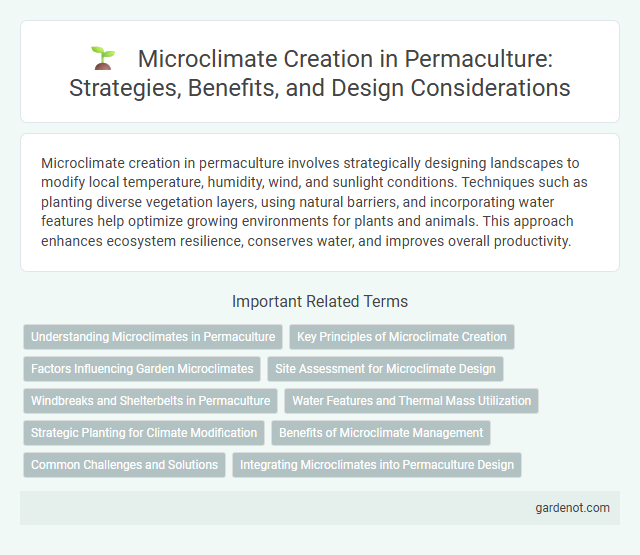Microclimate creation in permaculture involves strategically designing landscapes to modify local temperature, humidity, wind, and sunlight conditions. Techniques such as planting diverse vegetation layers, using natural barriers, and incorporating water features help optimize growing environments for plants and animals. This approach enhances ecosystem resilience, conserves water, and improves overall productivity.
Understanding Microclimates in Permaculture
Microclimate creation in permaculture involves analyzing factors such as sunlight exposure, wind patterns, humidity, and soil conditions to design sustainable ecosystems tailored to specific site conditions. Understanding microclimates allows for strategic placement of plants, water features, and structures to optimize growth, reduce erosion, and conserve energy. This knowledge enhances biodiversity, improves crop yields, and promotes environmental resilience within permaculture systems.
Key Principles of Microclimate Creation
Creating microclimates in permaculture involves strategic placement of elements such as windbreaks, water bodies, and vegetation to modify temperature, humidity, and wind patterns. Utilizing principles like maximizing solar gain, minimizing wind exposure, and enhancing thermal mass enables the development of favorable growing conditions tailored to specific plants. Understanding site-specific factors such as slope, aspect, and natural contours ensures effective microclimate design that boosts productivity and biodiversity.
Factors Influencing Garden Microclimates
Garden microclimates are shaped by factors such as sun exposure, wind patterns, soil type, and topography, which directly affect temperature, humidity, and moisture levels. Proximity to structures, tree canopies, and water bodies further modifies localized climate conditions, creating diverse niches for plant growth. Understanding these variables enables permaculture practitioners to design resilient garden systems tailored to specific environmental conditions.
Site Assessment for Microclimate Design
Site assessment for microclimate design involves analyzing factors such as soil type, slope, sunlight exposure, wind patterns, and existing vegetation to optimize permaculture system performance. Understanding these environmental variables allows for strategic placement of plants, water features, and structures to create favorable microclimates that enhance biodiversity and productivity. Detailed mapping and observation over seasonal cycles provide essential data for informed decision-making in microclimate optimization.
Windbreaks and Shelterbelts in Permaculture
Windbreaks and shelterbelts significantly enhance microclimate conditions in permaculture by reducing wind speed, which minimizes soil erosion and moisture loss. These vegetative barriers improve temperature regulation, protect crops from wind damage, and create more favorable growing conditions for diverse plants. Strategic placement of native trees and shrubs in windbreaks also supports biodiversity and increases overall ecosystem resilience.
Water Features and Thermal Mass Utilization
Water features such as ponds and swales enhance microclimate by increasing humidity and cooling surrounding areas through evaporation, benefiting plant growth and wildlife habitat. Thermal mass elements like stone walls or earth berms absorb heat during the day and release it at night, stabilizing temperature fluctuations in permaculture systems. Integrating water features with thermal mass optimizes microclimate control, promoting resilient and productive ecosystems.
Strategic Planting for Climate Modification
Strategic planting in permaculture involves selecting and positioning plant species to modify microclimates by providing shade, windbreaks, and humidity control. Trees and shrubs can lower ambient temperatures, reduce wind speed, and increase soil moisture retention, creating favorable conditions for diverse crops. This targeted vegetation design enhances energy efficiency and resilience in agroecosystems while promoting biodiversity.
Benefits of Microclimate Management
Microclimate management enhances permaculture by regulating temperature, wind, and humidity to create favorable growing conditions for diverse plant species. This targeted control boosts crop yields, reduces water usage, and minimizes pest problems by fostering biodiversity and natural pest predators. Effective microclimate creation also improves soil health through moderated moisture levels and reduced erosion risks.
Common Challenges and Solutions
Microclimate creation in permaculture often faces challenges such as unpredictable weather patterns, limited space, and soil degradation. Effective solutions include strategic plant placement to provide windbreaks, using mulch and organic matter to improve soil moisture retention, and incorporating water-harvesting techniques like swales and rain gardens. These practices enhance humidity regulation, temperature moderation, and protection from extreme weather, fostering a resilient and productive ecosystem.
Integrating Microclimates into Permaculture Design
Integrating microclimates into permaculture design enhances site productivity by optimizing temperature, moisture, and wind patterns tailored to specific plants and ecosystems. Strategic placement of trees, water bodies, and structures creates diverse microhabitats that support resilient plant growth and biodiversity. Microclimate management in permaculture maximizes energy efficiency, reduces water use, and promotes sustainable food production.
Microclimate creation Infographic

 gardenot.com
gardenot.com